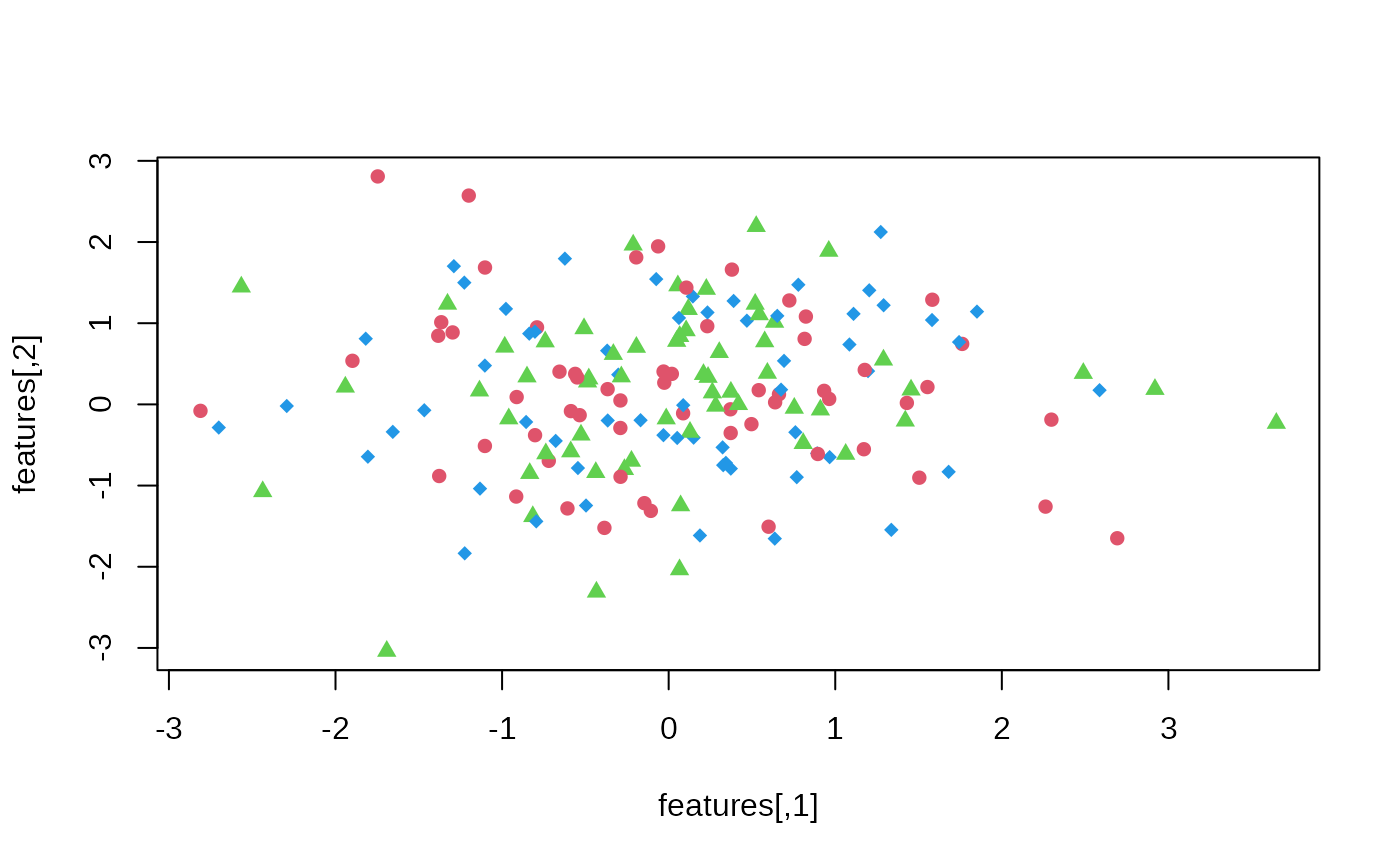Perform anticlustering using the k-plus objective to maximize between-group similarity. This function implements the k-plus anticlustering method described in Papenberg (2024; <doi:10.1111/bmsp.12315>).
kplus_anticlustering(
x,
K,
variance = TRUE,
skew = FALSE,
kurtosis = FALSE,
covariances = FALSE,
T = NULL,
standardize = TRUE,
...
)Arguments
- x
A feature matrix where rows correspond to elements and columns correspond to variables (a single numeric variable can be passed as a vector).
- K
How many anticlusters should be created. Alternatively: (a) A vector describing the size of each group, or (b) a vector of length
nrow(x)describing how elements are assigned to anticlusters before the optimization starts.- variance
Boolean: Should the k-plus objective include a term to maximize between-group similarity with regard to the variance? (Default = TRUE)
- skew
Boolean: Should the k-plus objective include a term to maximize between-group similarity with regard to skewness? (Default = FALSE)
- kurtosis
Boolean: Should the k-plus objective include a term to maximize between-group similarity with regard to kurtosis? (Default = FALSE)
- covariances
Boolean: Should the k-plus objective include a term to maximize between-group similarity with regard to covariance structure? (Default = FALSE)
- T
Optional argument: An integer specifying how many distribution moments should be equalized between groups.
- standardize
Boolean. If
TRUE, the data is standardized through a call toscalebefore the optimization starts. Defaults to TRUE. See details.- ...
Arguments passed down to
anticlustering. All of the arguments are supported except forobjective.
Details
This function implements the unweighted sum approach for k-plus anticlustering. Details are given in Papenberg (2024).
The optional argument T denotes the number of distribution
moments that are considered in the anticlustering process. For example,
T = 4 will lead to similar means, variances, skew and kurtosis.
For the first four moments, it is also possible to use the boolean
convenience arguments variance, skew and kurtosis; the
mean (the first moment) is always included and cannot be "turned off".
If the argument T is used, it overrides the arguments
variance, skew and kurtosis (corresponding to
the second, third and fourth moment), ignoring their values.
The standardization is applied to all original features and the
additional k-plus features that are appended to the data set in order
to optimize the k-plus criterion. When using standardization,
all criteria such as means, variances and skewness receive a comparable
weight during the optimization. It is usually recommended not
to change the default setting standardization = TRUE.
This function can use any arguments that are also possible in
anticlustering
(except for `objective` because the objective optimized here
is the k-plus objective; to use a different objective,
call anticlustering directly). Any arguments that are
not explicitly changed here (i.e., standardize = TRUE) receive the
default given in anticlustering
(e.g., method = "exchange".)
References
Papenberg, M. (2024). K-plus Anticlustering: An Improved k-means Criterion for Maximizing Between-Group Similarity. British Journal of Mathematical and Statistical Psychology, 77(1), 80–102. https://doi.org/10.1111/bmsp.12315
Examples
# Generate some data
N <- 180
M <- 4
features <- matrix(rnorm(N * M), ncol = M)
# standard k-plus anticlustering: optimize similarity with regard to mean and variance:
cl <- kplus_anticlustering(features, K = 3, method = "local-maximum")
mean_sd_tab(features, cl)
#> [,1] [,2] [,3] [,4]
#> 1 "0.02 (0.97)" "0.12 (0.98)" "0.03 (0.96)" "-0.06 (1.09)"
#> 2 "0.02 (0.97)" "0.12 (0.98)" "0.04 (0.96)" "-0.05 (1.08)"
#> 3 "0.02 (0.98)" "0.11 (0.98)" "0.04 (0.96)" "-0.05 (1.09)"
# Visualize an anticlustering solution:
plot(features, col = palette()[2:4][cl], pch = c(16:18)[cl])
 # Also optimize with regard to skewness and kurtosis
cl2 <- kplus_anticlustering(
features,
K = 3,
method = "local-maximum",
skew = TRUE,
kurtosis = TRUE
)
# The following two calls are equivalent:
init_clusters <- sample(rep_len(1:3, nrow(features)))
# 1.
x1 <- kplus_anticlustering(
features,
K = init_clusters,
variance = TRUE,
skew = TRUE
)
# 2.
x2 <- kplus_anticlustering(
features,
K = init_clusters,
T = 3
)
# Verify:
all(x1 == x2)
#> [1] TRUE
# Also optimize with regard to skewness and kurtosis
cl2 <- kplus_anticlustering(
features,
K = 3,
method = "local-maximum",
skew = TRUE,
kurtosis = TRUE
)
# The following two calls are equivalent:
init_clusters <- sample(rep_len(1:3, nrow(features)))
# 1.
x1 <- kplus_anticlustering(
features,
K = init_clusters,
variance = TRUE,
skew = TRUE
)
# 2.
x2 <- kplus_anticlustering(
features,
K = init_clusters,
T = 3
)
# Verify:
all(x1 == x2)
#> [1] TRUE